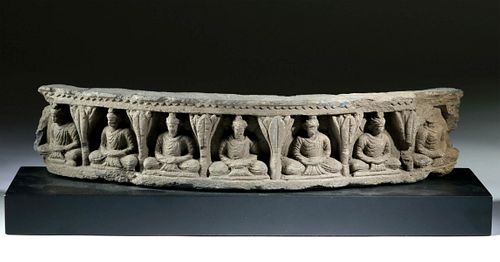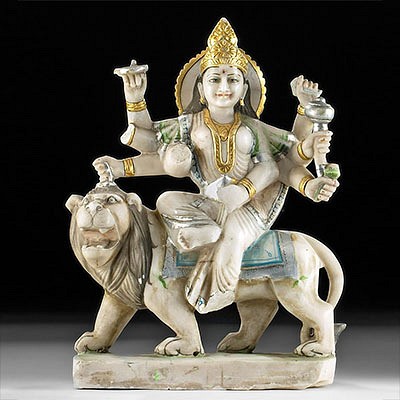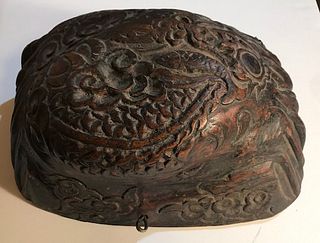1st C. Gandharan Schist Curved Relief - Seated Buddhas
Lot 82a
About Seller
Artemis Gallery
686 S Taylor Ave, Ste 106
Louisville, CO 80027
United States
Selling antiquities, ancient and ethnographic art online since 1993, Artemis Gallery specializes in Classical Antiquities (Egyptian, Greek, Roman, Near Eastern), Asian, Pre-Columbian, African / Tribal / Oceanographic art. Our extensive inventory includes pottery, stone, metal, wood, glass and textil...Read more
Categories
Estimate:
$2,500 - $3,500
Absentee vs Live bid
Two ways to bid:
- Leave a max absentee bid and the platform will bid on your behalf up to your maximum bid during the live auction.
- Bid live during the auction and your bids will be submitted real-time to the auctioneer.
Bid Increments
| Price | Bid Increment |
|---|---|
| $0 | $25 |
| $300 | $50 |
| $1,000 | $100 |
| $2,000 | $250 |
| $5,000 | $500 |
| $10,000 | $1,000 |
| $20,000 | $2,500 |
| $50,000 | $5,000 |
| $100,000 | $10,000 |
| $200,000 | $20,000 |
About Auction
By Artemis Gallery
Jul 16, 2020
Set Reminder
2020-07-16 10:00:00
2020-07-16 10:00:00
America/New_York
Bidsquare
Bidsquare : Ancient / Ethnographic Art Through The Ages
https://www.bidsquare.com/auctions/artemis-gallery/ancient-ethnographic-art-through-the-ages-5334
Ancient art from Egypt, Greece, Italy and the Near East, as well as Asian, Fossils, Pre-Columbian, Native American, African / Tribal / Oceanic, Spanish Colonial, Russian Icons, Fine art, much more! Artemis Gallery info@artemisgallery.com
Ancient art from Egypt, Greece, Italy and the Near East, as well as Asian, Fossils, Pre-Columbian, Native American, African / Tribal / Oceanic, Spanish Colonial, Russian Icons, Fine art, much more! Artemis Gallery info@artemisgallery.com
- Lot Description
Central Asia, Pakistan, India, and Afghanistan, Gandharan Empire, ca. 1st century CE. A long, gently curved panel section, perhaps from the base of a stupa or column. It is carved with a series of high relief seated Buddhas - seven of them visible here, though it is easy to imagine that when originally made it made a fully round disc of many more Buddhas! Each is separated by a large lotus flower in the process of unfolding; a scalloped upper border and flanged lower border bound the Buddhas in the panel. Each Buddha is identical, seated cross-legged in the Dhyana mudra. This is a gesture of meditation, with the hands placed in the lap, right hand on left, with fingers full stretched out and palms facing upwards. Size: 16.25" W x 3.3" H (41.3 cm x 8.4 cm); 4.95" H (12.6 cm) on included custom stand.
In the first century CE, Buddhism became fashionable amongst Gandharan elites, and the art produced at this time depicting the Buddha includes some of the most striking Buddhist images from the past. Their artistic tradition also reflects the conquest of Alexander the Great and the introduction of styles from Greek and Classical artwork, blended into a uniquely Gandharan tradition, which this carving exemplifies.
Provenance: private East Coast, USA collection; ex-Khan family collection, New Jersey, USA, 1980s
All items legal to buy/sell under U.S. Statute covering cultural patrimony Code 2600, CHAPTER 14, and are guaranteed to be as described or your money back.
A Certificate of Authenticity will accompany all winning bids.
We ship worldwide and handle all shipping in-house for your convenience.
#144379Piece is a fragment from a larger relief, with losses visible at either end. Five of the Buddhas are in excellent condition, while the other two have some losses - one to the head, one of the leg. Small scratches and chips from edges.Condition
- Shipping Info
-
All shipping is handled in-house for your convenience. Your invoice from Artemis Gallery will include shipping calculation instructions. If in doubt, please inquire BEFORE bidding for estimated shipping costs for individual items.
-
- Buyer's Premium



 EUR
EUR CAD
CAD AUD
AUD GBP
GBP MXN
MXN HKD
HKD CNY
CNY MYR
MYR SEK
SEK SGD
SGD CHF
CHF THB
THB














